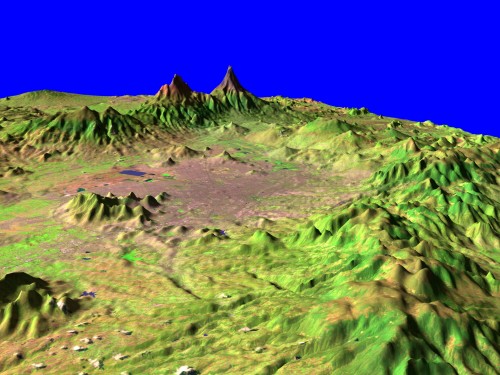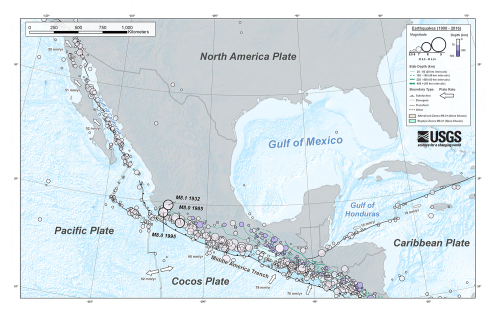
Mexico City: built on a basin of sedimentary rock from eroded mountains. (Courtesy: NASA/Goddard Space Flight Center Scientific Visualization Studio)
By James Dacey
At the time of writing, the official death toll stands at more than 200 people following the magnitude 7.1 earthquake that struck near Mexico City on Tuesday. According to the secretary of education, 200 schools have been affected, including the Enrique Rébsamen elementary school in Mexico City’s southern Coapa district where 37 people died, as reported by the BBC. Meanwhile buildings have collapsed at a campus of the Monterrey Institute of Technology killing five people and injuring 40, also in the south of the city.
In a cruel twist of fate, the quake struck on the day of the 32nd anniversary of the 1985 Mexico City earthquake that led to the death of up to 10 000 people. Even though yesterday’s event is likely to claim fewer victims than the 1985 disaster, it is still a shocking reminder of how vulnerable Mexico City is to earthquake damage.
Yesterday’s quake struck at 13:14 local time, with its epicentre around 115 km southwest of Mexico City’s urban centre. As with the 1985 event, the earthquake occurred along the fault zone where the oceanic Cocos plate submerges beneath the less dense continental section of the significantly larger North American plate. Energy is released in regular seismic events along this subduction zone – indeed, a magnitude 8.1 earthquake struck on 7 September just off Mexico’s southern coast, killing almost 100 people, mostly in the state of Oaxaca.

Mexico sits at the boundary of three tectonic plates: the Cocos plate, the North American plate, and the Pacific plate. (Courtesy: USGS)
So why is Mexico City so prone to earthquake disasters?
The image at the top of this article – produced using data from NASA’s Landsat Thematic Mapper – is a view across Mexico City from the north-northwest with the stratovolcanoes Popocatépetl and Iztacihuatl visible in the background. It reveals that the city lies in a basin that used to contain Lake Texcoco, which was drained by the Spanish conquistadors from the 17th century onwards. What was left behind were the sediments from the lake bed, which form a so-called “lacustrine sequence”. This resulting geology is a key factor in why modern day Mexico City is so vulnerable to earthquake damage, according to Jaime Urrutia Fucugauchi, a geophysicist at the National Autonomous University of Mexico (UNAM).
Urratia says these sedimentary beds have a characteristic frequency response and ground motions can be accelerated locally, depending on factors such as the size and orientation of buildings. There may also be a secondary effect from seismic waves becoming “trapped” inside the basin, which is underlaid with volcanic rocks. Urrutia compares the resulting amplification effect to a wine glass making a ringing sound when it is exposed to certain frequencies. He says that intermediate-sized buildings in the central and southern sectors of Mexico City are particularly at risk from this effect, as was observed in the 1985 event.
“Infrastructure is more adequate now [than in 1985], though problems persist as shown by the collapsed buildings,” says Urrutia. He adds that only minor damage has been reported at the sprawling UNAM campus, a major hub for Mexican physics.
Arturo Menchaca Rocha, a UNAM physicist, says Mexico City’s geology behaves like a gel, producing chaotic resonant patterns on its surface. “When the characteristic wavelength of a local resonance coincides with a building height (or is a sub-multiple of it), the structure resonates too, magnifying the effect,” he explains.
Menchaca is not aware of any damage to Mexico’s major physics facilities such as the HAWC Gamma-Ray Observatory or the Large Millimeter Telescope, both located on Sierra Negra extinct volcano in Puebla. But some of his colleagues in Mexico City have reported damage to measuring devices falling from their desks.
Find out more about why it is so difficult to predict when and where the next major earthquake will strike, by watching this short film On Shaky Ground.
You can also read this Physics World special report on physics in Mexico, including a plan to use muons to help predict eruptions of the Popocatépetl volcano.
Guidelines
Show/hide formatting guidelines
this text was deletedwhere people live in harmony with nature and animals</q>
Some text